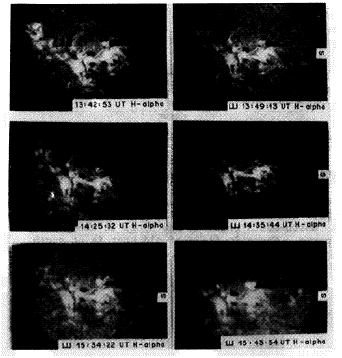
This nugget discusses the X-class solar flares that happened right after the "Murphy's revenge" science nugget was written. The significance of the "birds of a feather" title is that these flares, to first glance, appeared to be "homologous", i.e., they matched closely in appearance and behavior. Sometimes one sees two successive flares which have uncanny similarities, and this is a property (among many, of course) that solar flare theorists have not dealt with successfully yet. To summarize, we conclude that these X-class flares are probably similar, though not homologous, but we go on to discuss the problems anyway.
Of course, we can't tell very well about the homology (Merriam-Webster says 1 : a similarity often attributable to common origin ) of these events just from the Yohkoh soft X-ray images alone, but here is what they look like, following the Sun's rotation to put them in approximately the proper position:

Note that they took place at intervals of just about one day. Taking into account that they are viewed from different angles (solar rotation changes the angle by about 13 degrees per day), they all seem to show cusps, though the November 25th flare has what seems to be additional compact loops at the base of its cusp. Pretty similar, eh? But not exactly. The concept of homology extends to their temporal behavior, so here are the three standard X-ray plots for the November 24, November 25, and November 26 events. Pretty similar, eh? But not exactly. In these plots we show the soft X-ray (GOES) and hard X-ray (Yohkoh HXT 23-33 keV) time histories, normalized and plotted on a linear scale.
The repeated theme of "Pretty similar, eh? But not exactly" expresses the difficulty in drawing an immediate strong conclusion, as described below. It would be wonderful to compare the flares at other wavelengths, in particular with high-resolution H-alpha data. Here's a rather terrible example in H-alpha from a paper by Trevisan et al. (it has an abstract in Portuguese) making the interesting point that not only do the H-alpha images look strikingly similar, but so do the microwave time histories that reflect particle acceleration (as do the hard X-rays for our X flares).

We almost universally believe that solar flares (and CMEs) derive their energy from the magnetic field in the solar corona, and because the flare radiation and/or CME mass flux escapes from the Sun, this energy has been dissipated irreversibly. So - and this is the simplest possible question, we think - How do you put the structure back together in exactly the same way? In these events it's striking, because each event (although not involving a long-decay arcade-type event) actually produced a CME, which we think involves a catastrophic opening of the field lines. How do you re-close them just so? The simplest possible interpretation would be that large-scale magnetic restructuring is not essential to the flare, which would have to derive its energy from unresolved small-scale structures whose annihilation would leave the morphology intact.
The next more complicated interpretation is that, well, we never have strict homology. Then perhaps the same field lines exactly don't have to be involved in repeated flaring. This would be possible in an emerging flux scenario, even if it involved seemingly irrevocable magnetic reconnection. This is the interpretation suggested by emerging-flux scenario Ranns et al. in a recent paper, for example, even though their paper actually state that the "[The two flares] certainly share some common footpoints and, within the resolution of SXT, appear to share the same principal flare footpoints", which seems to leave the solution to this problem unfinished.
Could emerging flux really lead to very (very, very in some cases) similar events? Ranns et al. used the term "random" to describe flux emergence, but it really isn't. The solar magnetic field has correlations, both in space and in time, on a whole spectrum of scales. So the idea that homologous flares result from homologous flux emergence is not as vacuous, say, as the Big Bang cosmology - we can hope to fathom the reasons for these correlations by studying the solar interior by means of helioseismology, something the cosmologists can never aspire to!
Despite Murphy's Law, Yohkoh got great observations of these X-class flares, and we understand that TRACE and SOHO also did. Because of their near-homology and eccentricity (impulsive flares with CMEs) we want to do much more analysis. So, stay tuned for another nugget some time soon.
December 8, 2000
Hugh Hudson <hudson@isass0.solar.isas.ac.jp>